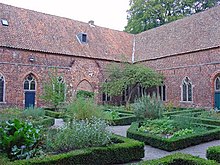Ter Apel
| province |
|
| local community | Westerwolde |
|
Area - land - water |
24.92 km 2 24.3 km 2 0.62 km 2 |
| Residents | 9,045 (Jan 1, 2017) |
| Coordinates | 52 ° 53 ' N , 7 ° 4' E |
| Important traffic route |
|
| prefix | 0599 |
| Postcodes | 7831, 7877, 7881, 7895, 9551, 9561 |
The town of Ter Apel is located in the north of the Netherlands in the province of Groningen and, with 9,045 inhabitants (as of January 1 2017), the largest village in the municipality of Westerwolde .
location
The place is on the edge of the Bourtanger Moors and borders in the east, near Rütenbrock , on Lower Saxony , and in the southwest on the Drentsche Emmen .
The Ruiten Aa , the upper reaches of the Westerwoldsche Aa, rises on the eastern edge of the village .
history
The place emerged from a monastery of the Order of the Holy Cross . It was founded in 1465 by monks from the Bentlage monastery and called Nova Lux from Latin New Light . Heinrich van den Berg was the first abbot of the Nova Lux monastery until 1487. In 1594 the monastery was closed as a result of the introduction of the Reformation .
In the 1970s, numerous single-family houses were built around the swimming lake in the center of the village, which contributed significantly to the growth of the village.
In 2017, a refugee reception center was opened in Ter Apel as the central reception camp for the Netherlands, which can accommodate up to 2000 people. Asylum procedures there are usually carried out within eight days. The center employs around 600 people from all areas necessary to carry out the procedure.
Attractions
The brick monastery , built in 1465 , has been open to the public since June 2010.
traffic
Streets
Ter Apel lies at the intersection of the Dutch provincial roads N364 , N366 and N379 ; The Haren junction on the A 31 is only about 10 km to the east in German territory . The cities of Stadskanaal and Emmen are each a good 15 km northwest and southwest of Ter Apel in the Netherlands, the closest German city Haren is 14 km southeast.
railroad
The branch lines to the neighboring towns of Emmen and Stadskanaal have been closed, the latter (via Musselkanaal and Zandberg) since 1972 and largely dismantled. At the beginning of the 20th century it was planned to continue the railway line from Stadskanaal to Ter Apel to Meppen . In 1910, the Prussian government granted the Meppen district the building permit for the German section of the route . But the First World War put the project on hold. In 1920 the district of Meppen made a second attempt. This time inflation prevented the project from being realized. A third attempt after the introduction of the Rentenmark also failed. Meanwhile, the Dutch railway company Stadskanaal-Ter Apel-Rijksgrens (STAR) had completed the line from Ter Apel to the border, trusting the German promise. It started operations in 1924. However, it was unprofitable from the start, as it ended at the border and remained without a connection to the German network. After only two years, the branch line to the border was closed - and only really known. Because the STAR line was and is the Dutch railway line with the shortest operating time.
Sports
The “De Polderputten” autospeedway and stock car track is located in Ter Apel and is operated by the NNO (Noord Nederlandse Ovalracing) and connected to the Dutch motor sports authority KNAF. Various motorsport classes drive on the 460 m or 320 m long track.
The local swimming club Zepta Ter Apel holds one of the largest water polo tournaments in the world every year with more than 150 participating teams .
Web links
- Website of the Ter Apel Museum Monastery (Dutch, German, English)
- In conversation with the monastery guide about Ter Apel (German)
- Website of the autospeedway train "De Polderputten" (Dutch)
Individual evidence
- ↑ a b Kerncijfers wijken en buurten 2017 Centraal Bureau voor de Statistiek , accessed on June 29, 2018 (Dutch)
- ↑ Thomas Giessmann, Mechtild Huesmann, Lothar Kurz (arr.): The chronicle of the Bentlage monastery before Rheine. Edition and translation . Aschendorff, Münster 2011, ISBN 978-3-402-12889-3 , p. 87.
- ↑ Thomas Giessmann, Mechtild Huesmann, Lothar Kurz (arr.): The chronicle of the Bentlage monastery before Rheine. Edition and translation . Aschendorff, Münster 2011, p. 123.
- ↑ Kerstin Schweighöfer: Nobody should feel at home in the Ter Apel refugee center on Deutschlandfunk from July 4, 2018
- ↑ Fiona Erhlers: Short process . In: Der Spiegel . No. 27 , 2018, p. 30-32 ( Online - June 30, 2018 ).
- ↑ De geschiedenis van de NOLS in chronologische volgorde, 1970–1979 , accessed on October 20, 2016.
- ^ Meppen-Ter Apel railway construction. Memorandum of the district commission for the railway construction Meppen-Ter Apel with branch line Fullen-Gross-Hesepe . Self-published by the Meppen District Commission, Meppen 1920.
- ↑ The economic importance of the “Meppen-Ter-Apel” railway as a developer of the Bourtanger moor and the adjoining heathland (published in 1925 or 1925).
- ↑ Anneke Huyser: Van NOLS dead STAR. A historical schets van Museumspoorlijn Veendam-Stadskanaal-Musselkanaal . Uitgeverij De Wijze Kater, Utrecht 2002, ISBN 90-5111-002-2 .
